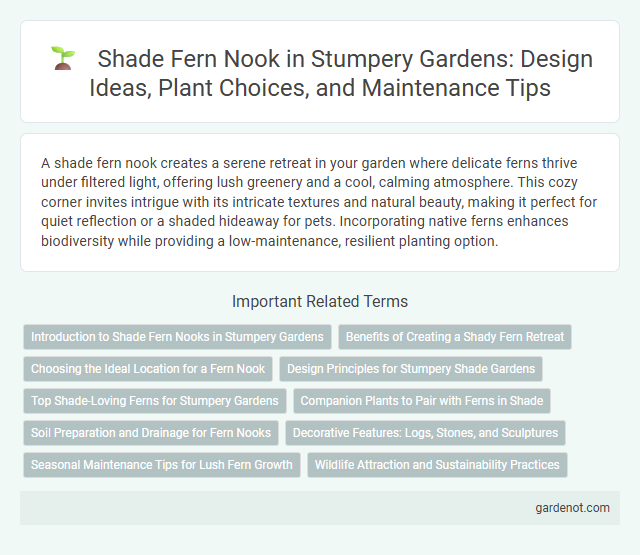A shade fern nook creates a serene retreat in your garden where delicate ferns thrive under filtered light, offering lush greenery and a cool, calming atmosphere. This cozy corner invites intrigue with its intricate textures and natural beauty, making it perfect for quiet reflection or a shaded hideaway for pets. Incorporating native ferns enhances biodiversity while providing a low-maintenance, resilient planting option.
Introduction to Shade Fern Nooks in Stumpery Gardens
Shade fern nooks in stumpery gardens create ideal microhabitats for diverse fern species, thriving under filtered light and cool, moist conditions. These shaded corners often feature decaying wood and stones that provide natural substrates, enhancing fern growth and biodiversity. Incorporating shade fern nooks boosts the ecological balance and visual appeal of stumpery garden designs.
Benefits of Creating a Shady Fern Retreat
A shady fern nook provides a unique microclimate ideal for moisture-loving shade ferns, promoting lush growth and vibrant greenery throughout the year. Creating this cool, sheltered environment enhances biodiversity by attracting beneficial insects and wildlife, while also reducing garden maintenance through natural ground cover. Integrating a stumpery with native ferns boosts soil health and offers a tranquil retreat perfect for relaxation and nature appreciation.
Choosing the Ideal Location for a Fern Nook
Selecting the ideal location for a shade fern nook requires focusing on areas with consistent indirect sunlight and high humidity to mimic natural fern habitats. Positioning the nook under dense tree canopies or near shaded garden corners ensures adequate moisture retention and protection from harsh winds. Soil should be rich in organic matter, well-draining yet moist, to support the delicate root systems of shade-loving ferns.
Design Principles for Stumpery Shade Gardens
Shade fern nooks in stumpery design prioritize low-light-tolerant ferns such as Dryopteris and Polystichum for lush, textured foliage. Incorporating decaying logs and varied stump heights enhances moisture retention and microhabitats, fostering biodiversity within the shade garden. Layering shade-loving groundcovers like Asarum with ferns creates depth and visual interest while maintaining ecological balance.
Top Shade-Loving Ferns for Stumpery Gardens
Shade fern nooks thrive with top shade-loving ferns such as Polystichum munitum (Western Sword Fern), Athyrium filix-femina (Lady Fern), and Dryopteris marginalis (Marginal Wood Fern). These ferns excel in low-light, moist conditions typical of stumpery gardens, creating lush, textured greenery that complements aged wood and moss. Incorporating these species enhances biodiversity and ensures year-round visual interest in shaded garden corners.
Companion Plants to Pair with Ferns in Shade
Shade fern nooks thrive when paired with companion plants like hostas, astilbes, and heucheras, which complement the ferns' texture and color while thriving in low-light conditions. These plants share similar moisture and soil requirements, enhancing the overall health and aesthetic of shaded garden areas. Incorporating native woodland groundcovers such as foamflower and wild ginger can further enrich the biodiversity and resilience of a stumpery garden.
Soil Preparation and Drainage for Fern Nooks
Shade fern nooks thrive in well-drained, acidic soil rich in organic matter, mimicking their natural woodland environment. Proper soil preparation involves incorporating ample leaf mold, compost, and pine needles to enhance moisture retention while ensuring sufficient aeration. Effective drainage prevents waterlogging, which is crucial to avoid root rot and maintain the delicate balance required for healthy fern growth.
Decorative Features: Logs, Stones, and Sculptures
Shade fern nooks in a stumpery are enriched by the careful arrangement of decorative features such as logs, stones, and sculptures that create a naturalistic and textured environment. Weathered logs serve as organic platforms for growing ferns, while moss-covered stones add visual contrast and depth. Handcrafted sculptures, often inspired by woodland themes, provide focal points that enhance the garden's whimsical and serene atmosphere.
Seasonal Maintenance Tips for Lush Fern Growth
Shade fern nooks thrive in moist, well-drained soil rich in organic matter, requiring regular watering to maintain consistent humidity for vibrant fronds. Seasonal maintenance involves removing dead or yellowing fronds in early spring to encourage new growth and applying a balanced, slow-release fertilizer every 6-8 weeks during the growing season. Mulching with leaf litter or bark chips conserves moisture, suppresses weeds, and protects root systems from temperature fluctuations, ensuring lush and healthy fern development throughout the year.
Wildlife Attraction and Sustainability Practices
Shade fern nooks create ideal habitats that attract diverse wildlife such as amphibians, birds, and beneficial insects by providing moisture and shelter. Utilizing native fern species in the nook supports local biodiversity and reduces water consumption, aligning with sustainable gardening practices. The dense canopy of shade ferns also helps regulate soil temperature and prevent erosion, contributing to an eco-friendly landscape design.
Shade fern nook Infographic

 gardenot.com
gardenot.com